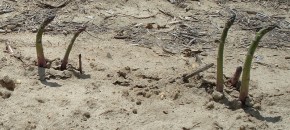We recorded 56-58°F temperatures from soils in various Central Jersey commercial vegetable fields on April 15 –Tax Day– just before the recent multi-day cold front rolled in. The good news is 56-58°F was higher than I anticipated. What do soil temperatures have to do with your early vegetable seedlings? Mean spring soil temperatures determine early […]
Continue reading...ABW Part 2: Managing Insecticide Resistant Populations

Having touble controlling your Annual Bluegrass Weevil (ABW) populations? You’re not alone. Insecticide resistance in ABW is a growing and expanding problem. And because the major resistance mechanism involved, enhanced metabolic detoxification of the insecticide active ingredients, is not very specific, the resistance can be very broad.
Continue reading...Spring Asparagus Production Notes
If you are planting a new field of asparagus or getting ready to harvest emerging spears, here are some thoughts: Are you planting 1-year old crowns or did you seed cell trays and are going to plant seedlings? Remember, 1 year old crowns are planted and not harvested that year. In the second year, only harvest […]
Continue reading...Pesticide Storage Inventory Due May 1
All NJ licensed pesticide applicators, as well as dealers, who store pesticides are required by law to send a copy of their storage inventories with an explanatory cover letter to the local fire company by May 1st each year.
Continue reading...Spear Damage in Asparagus

Spear damage in asparagus can be caused by diseases such as Phytophthora spear and crown rot and purple spot. However, other environmental factors during the spring can damage spears as they emerge from the soil. Wind – Periods of heavy winds during emergence will cause spears to bend. Winds can cause one side of the […]
Continue reading...Controlling Spring Diseases in Asparagus
Asparagus season is just around the corner and now is a good time to review important diseases. With the long, wet spring we’ve encountered this year many fields have been extremely wet for long periods of time. These types of soil conditions are ideal for Phytophthora and Pythium development. To help reduce potential losses, especially […]
Continue reading...